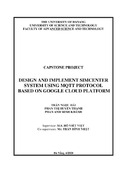
Please use this identifier to cite or link to this item:
http://thuvienso.dut.udn.vn/handle/DUT/4113| DC Field | Value | Language |
|---|---|---|
| dc.contributor.advisor | Ho, Viet Viet, M.Sc. | |
| dc.contributor.author | Tran, Ngoc Hai | |
| dc.contributor.author | Phan, Thi Huyen Thanh | |
| dc.contributor.author | Phan, Anh Minh Khanh | |
| dc.date.accessioned | 2024-11-06T05:20:05Z | - |
| dc.date.available | 2024-11-06T05:20:05Z | - |
| dc.date.issued | 2020 | |
| dc.identifier.uri | http://thuvienso.dut.udn.vn/handle/DUT/4113 | - |
| dc.description | DA.FA.20.013 ; 94 p. | vi |
| dc.description.abstract | Early smart home devices often relied on Wi-Fi, Zigbee and Bluetooth to communicate. However, using Wi-Fi drains power so quick, also the stability is not high and even occupies the network bandwidth. With Bluetooth and Zigbee, the control distance of devices is narrowed, causing restrictions for multi-floor houses. Importantly, the use of the HTTP protocol for transmitting and receiving information between devices also has some limitations such as large packet size, long transmission time and unnecessary information lead to poor performance of the system. Design and Implement SimCenter System using MQTT Protocol based on Google Cloud Platform is carried out with the aim to fully understand the concept of Peripheral Interface Controller, deeply comprehended Message Queuing Telemetry Transport Protocol, and its components. Furthermore, this project intends to response the requirement of the market: improve performance, stability of the system and bring low-cost wireless connectivity for smart home devices. With the new protocol, the compact size of MQTT’s packet and its Quality of Service are geared toward reliable Machine-to-Machine communication at a fundamental level, requiring few workarounds to operate smoothly. We aim to a better solution for exchanging data at a faster speed, lighter packets but still full of necessary information. We also show that LoRa, designed by having in mind the typical requirements of Internet of Things (low power consumption, long-range transmission, and robustness to interference), is well-suited to also meet the need of established smart home systems, specifically the low latency in message delivery. Finally, we have completed the project by design and implement the SimCenter System, allows users to directly control smart devices such as Smart switches, TV, Air conditioner, doors, and gates, … in the most convenient and simplest way with a mobile application on smart phone | vi |
| dc.language.iso | en | vi |
| dc.publisher | Trường Đại học Bách khoa - Đại học Đà Nẵng | vi |
| dc.subject | Simcenter | vi |
| dc.subject | Cloud platform | vi |
| dc.subject | Google cloud | vi |
| dc.title | Design and implement simcenter system using MQTT protocol based on Google cloud platform | vi |
| dc.type | Đồ án | vi |
| item.cerifentitytype | Publications | - |
| item.openairetype | Đồ án | - |
| item.fulltext | Có toàn văn | - |
| item.grantfulltext | restricted | - |
| item.openairecristype | http://purl.org/coar/resource_type/c_18cf | - |
| item.languageiso639-1 | en | - |
| Appears in Collections: | Khoa Khoa học Công nghệ tiên tiến - Điện tử Viễn thông | |
Files in This Item:
| File | Description | Size | Format | Existing users please Login |
|---|---|---|---|---|
| 7.DA.FA.20.013.TranNgocHai.pdf | Thuyết minh | 20.7 MB | Adobe PDF |  |
CORE Recommender
Page view(s) 20
44
checked on Dec 31, 2025
Download(s) 50
11
checked on Dec 31, 2025
Google ScholarTM
Check
Items in DSpace are protected by copyright, with all rights reserved, unless otherwise indicated.